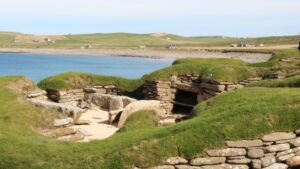
We have a very short-term relationship with material culture these days. Nothing lasts for long and we are ever keen to seek a new version, the most up to date model. It is true with regard to both our largest and our smallest possessions. The oldest things I own date back to the early twentieth century, though they do have strong family associations. There is a carved and worn wooden bread board, and an elaborate brass-decorated barometer. Neither has much intrinsic value, but they are significant for me because of the image they evoke of my grandfather’s house in London, and the people therein. These items are not even that old, a mere hundred years or so. My house is a bit older than that, some 160 years, but it has only been my house for less than 20 years.
A book I have been reading has got me thinking about a time when houses were something very different. Mark Edmonds’ Orcadia, Land Sea and Stone in Neolithic Orkney, takes us back some 5500 years to a place where, he suggests, houses were more of a skin, an outer definition of family, an evocation of your lineage and ancestors.
Today we have commoditised everything. Perhaps even our relationships, certainly our possessions. We easily discard what we have and change it at the drop of a hat. Goods hold little intrinsic value, instead they facilitate our lifestyle and our image. We do not wish to be out of date. Such is our reliance on technology that change is often forced on us as operating systems are updated, or objects no longer serve their function.
Even our homes rarely last. Some of us move on every few years or so, few people stay at the same address for more than twenty years, and we speak with awe of those who have inhabited the same property for more than forty years. Imagine then a time when your home was a given, something built generations ago and inherently bound into your lineage. It might change, even adapt to accommodate new generations, new needs, but it was you.
It is a complicated idea to grasp (hopefully I have got it right). Perhaps we can begin to approach it through a consideration of the castles and stately homes that still exist within the countryside today. Many lie uninhabited, often ruinous, but in their heyday they comprised nodes within a mesh, a network of significant human relations that gave order to society. Though once a stable and familiar norm that transcended the generations, it was not without its problems, I know, but sadly that network has now collapsed.
Though the details of prehistoric society were very different, Edmonds postulates a similar association across generations and community between the well-built stone houses of late Neolithic Orkney and the inhabitants of the islands. It is hard to contemplate the idea that your house might be more than just a symbol of ‘how you live now’. Something that encapsulates not just your parents and grandparents (if only), but generations long gone. Generations who have disappeared into the mists of myth and story.
It is an idea I like to think about.
Few of us would seek to set up that sort of longevity today. And many details of the system Edmonds posits remain unclear. What happened as children multiplied? Did the formation of family partnerships introduce any sort of mobility? How big was a family? How many generations? Would the system work in places (like most of the rest of Britain) where houses were built of timber rather than stone? Was Orkney special? Was it just the dwelling house, or the association between home, tomb and land? Was there even any perceived difference between home, tomb and land? We separate the living from the dead very strictly today, and few of us have any deep link to the land wherein we live. But things have not necessarily always been thus. Maybe, once upon a time, they were one and the same.
I like books that move me out of my comfort zone. Ideas that challenge me to develop new perceptions, to see beyond my cosy middle-class western horizons.
This book certainly does that. Of course, you don’t have to agree with everything. That is the fun of archaeology – there is always a new story. It is nice to be around when one comes along
You must be logged in to post a comment.